Experimental Study on Bluff-Body Stabilized Premixed Flame with a Central Air/Fuel Jet
Abstract
:1. Introduction
2. Apparatus and Methods
2.1. Experimental Apparatus
2.2. High-Speed Photography
2.3. Thermography
3. Results and Discussions
3.1. Flame Structures
3.2. Blowout Limits
3.3. Bluff-Body Upper Surface Temperature
4. Conclusions
- A central air jet makes the premixed annular flame more unstable leading to an easier blowout of the annular flame.
- Two different flame blowout phenomena: With/without the occurrence of split-flashing flame mode, was observed with a central air jet injection.
- With a central air/fuel jet, the temperature on the upper surface of the bluff-body was reduced noticeably.
- The reduction in the temperature on the surface of the bluff-body with a central fuel injection is found to be caused by the flame lifting off from the bluff-body. The liftoff height increases with the increase in the mass flow rate of the central fuel flow, while the temperature of the bluff-body being decreased correspondingly.
- Under conditions with a central fuel jet, the annular premixed flame was found unsteadily attached at the outer edge of the bluff-body. That attached point had a circular motion along the outer edge of the bluff-body. The dominant frequency of the oscillation of the flame tip decreased with an increase in the velocity of the central fuel jet.
Acknowledgments
Author Contributions
Conflicts of Interest
References
- Chaudhuri, S.; Cetegen, B.M. Blowoff characteristics of bluff-body stabilized conical premixed flames with upstream spatial mixture gradients and velocity oscillations. Combust. Flame 2008, 153, 616–633. [Google Scholar] [CrossRef]
- Guo, P.; Zang, S.; Ge, B. Technical brief: Predictions of flow field for circular-disk bluff-body stabilized flame investigated by large eddy simulation and experiments. J. Eng. Gas Turbines Power 2010, 132, 054503. [Google Scholar] [CrossRef]
- Zukoski, E.E.; Marble, F.E. The role of wake transition in the process of flame stabilization on bluff bodies. In AGARD Combustion Researches and Reviews; Butterworths: London, UK, 1955. [Google Scholar]
- Zuikoski, E.; Marble, F. Gas Dynamic Symposium on Aerothermochemistry; Northwestern University Press: Evanston, IL, USA, 1955. [Google Scholar]
- Longwell, J. Flame Stabilization by Bluff Bodies and Turbulent Flames in Ducts. Symp. (Int.) Combust. 1953, 4, 90–97. [Google Scholar] [CrossRef]
- Longwell, J.P.; Frost, E.E.; Weiss, M.A. Flame stability in bluff body recirculation zones. Ind. Eng. Chem. 1953, 45, 1629–1633. [Google Scholar] [CrossRef]
- Wright, F. Bluff-body flame stabilization: Blockage effects. Combust. Flame 1959, 3, 319–337. [Google Scholar] [CrossRef]
- Pan, J.; Vangsness, M.; Ballal, D. Aerodynamics of Bluff Body Stabilized Confined Turbulent Premixed Flames. J. Eng. Gas Turbines Power 1992, 114, 783–789. [Google Scholar] [CrossRef]
- Lefebvre, A.H.; Ballal, D.R. Gas Turbine Combustion; CRC Press: Boca Raton, FL, USA, 2010. [Google Scholar]
- Barrere, M.; Mestre, A. Selected Combustion Problems; Stabilisation des Flammes par des Obstacles; Butterworth Scientific Publications: London, UK, 1954. [Google Scholar]
- Shanbhogue, S.J.; Husain, S.; Lieuwen, T. Lean blowoff of bluff body stabilized flames: Scaling and dynamics. Prog. Energy Combust. Sci. 2009, 35, 98–120. [Google Scholar] [CrossRef]
- Chaparro, A.A.; Cetegen, B.M. Blowoff characteristics of bluff-body stabilized conical premixed flames under upstream velocity modulation. Combust. Flame 2006, 144, 318–335. [Google Scholar] [CrossRef]
- Chaudhuri, S.; Cetegen, B.M. Blowoff characteristics of bluff-body stabilized conical premixed flames in a duct with upstream spatial mixture gradients and velocity oscillations. Combust. Sci. Technol. 2009, 181, 555–569. [Google Scholar] [CrossRef]
- Chaudhuri, S.; Kostka, S.; Renfro, M.W.; Cetegen, B.M. Blowoff dynamics of bluff body stabilized turbulent premixed flames. Combust. Flame 2010, 157, 790–802. [Google Scholar] [CrossRef]
- Wan, J.; Fan, A.; Maruta, K.; Yao, H.; Liu, W. Experimental and numerical investigation on combustion characteristics of premixed hydrogen/air flame in a micro-combustor with a bluff body. Int. J. Hydrogen Energy 2012, 37, 19190–19197. [Google Scholar] [CrossRef]
- Fan, A.; Wan, J.; Liu, Y.; Pi, B.; Yao, H.; Liu, W. Effect of bluff body shape on the blow-off limit of hydrogen/air flame in a planar micro-combustor. Appl. Therm. Eng. 2014, 62, 13–19. [Google Scholar] [CrossRef]
- Bagheri, G.; Hosseini, S.E.; Wahid, M.A. Effects of bluff body shape on the flame stability in premixed micro-combustion of hydrogen–air mixture. Appl. Therm. Eng. 2014, 67, 266–272. [Google Scholar] [CrossRef]
- Fan, A.; Wan, J.; Maruta, K.; Yao, H.; Liu, W. Interactions between heat transfer, flow field and flame stabilization in a micro-combustor with a bluff body. Int. J. Heat Mass Transf. 2013, 66, 72–79. [Google Scholar] [CrossRef]
- Roquemore, W.; Tankin, R.; Chiu, H.; Lottes, S. A study of a bluff-body combustor using laser sheet lighting. Exp. Fluids 1986, 4, 205–213. [Google Scholar] [CrossRef]
- Caetano, N.R.; da Silva, L.F.F. A comparative experimental study of turbulent non premixed flames stabilized by a bluff-body burner. Exp. Therm. Fluid Sci. 2015, 63, 20–33. [Google Scholar] [CrossRef]
- Esquiva-Dano, I.; Nguyen, H.; Escudie, D. Influence of a bluff-body’s shape on the stabilization regime of non-premixed flames. Combust. Flame 2001, 127, 2167–2180. [Google Scholar] [CrossRef]
- Schefer, R.; Namazian, M.; Kelly, J.; Perrin, M. Effect of confinement on bluff-body burner recirculation zone characteristics and flame stability. Combust. Sci. Technol. 1996, 120, 185–211. [Google Scholar] [CrossRef]
- Tang, H.; Yang, D.; Zhang, T.; Zhu, M. Characteristics of flame modes for a conical bluff body burner with a central fuel jet. J. Eng. Gas Turbines Power 2013, 135, 091507. [Google Scholar] [CrossRef]
- Nishimura, T.; Kaga, T.; Shirotani, K.; Kadowaki, J. Vortex structures and temperature fluctuations in a bluff-body burner. J. Vis. 1998, 1, 271–281. [Google Scholar] [CrossRef]
- Euler, M.; Zhou, R.; Hochgreb, S.; Dreizler, A. Temperature measurements of the bluff body surface of a swirl burner using phosphor thermometry. Combust. Flame 2014, 161, 2842–2848. [Google Scholar] [CrossRef]
- Euler, M.; Zhou, R.; Hochgreb, S.; Dreizler, A. Temperature Measurements of the Bluff Body Surface of Cambridge Stratified Swirl Burner Using Phosphor Thermometry. In Proceedings of the European Combustion Meeting, Lund, Sweden, 25–28 June 2013; p. 33. [Google Scholar]
- Russi, M.; Cornet, I.; Cornog, R. The influence of flame holder temperature on flame stabilization. In Symposium (International) on Combustion; Elsevier: Amsterdam, The Netherlands, 1953; pp. 743–748. [Google Scholar]
- Lin, C.-X.; Holder, R.J. Reacting turbulent flow and thermal field in a channel with inclined bluff body flame holders. J. Heat Transf. 2010, 132, 091203. [Google Scholar] [CrossRef]
- Li, M.; Tong, Y.; Klingmann, J.; Thern, M. Impact of vitiation on a swirl-stabilized and premixed methane flame. Energies 2017, 10, 1557. [Google Scholar] [CrossRef]
- Tong, Y.; Li, M.; Thern, M.; Klingmann, J. An experimental study of effects of confinement ratio on swirl stabilized flame macrostructures. In Proceedings of the ASME 2017 Power Conference Joint With ICOPE-17 Collocated with the ASME 2017 11th International Conference on Energy Sustainability, the ASME 2017 15th International Conference on Fuel Cell Science, Engineering and Technology, and the ASME 2017 Nuclear Forum, Charlotte, NC, USA, 26–30 June 2017; American Society of Mechanical Engineers: New York, NY, USA, 2017; p. V001T004A007. [Google Scholar]
- Coats, C. Coherent structures in combustion. Prog. Energy Combust. Sci. 1996, 22, 427–509. [Google Scholar] [CrossRef]
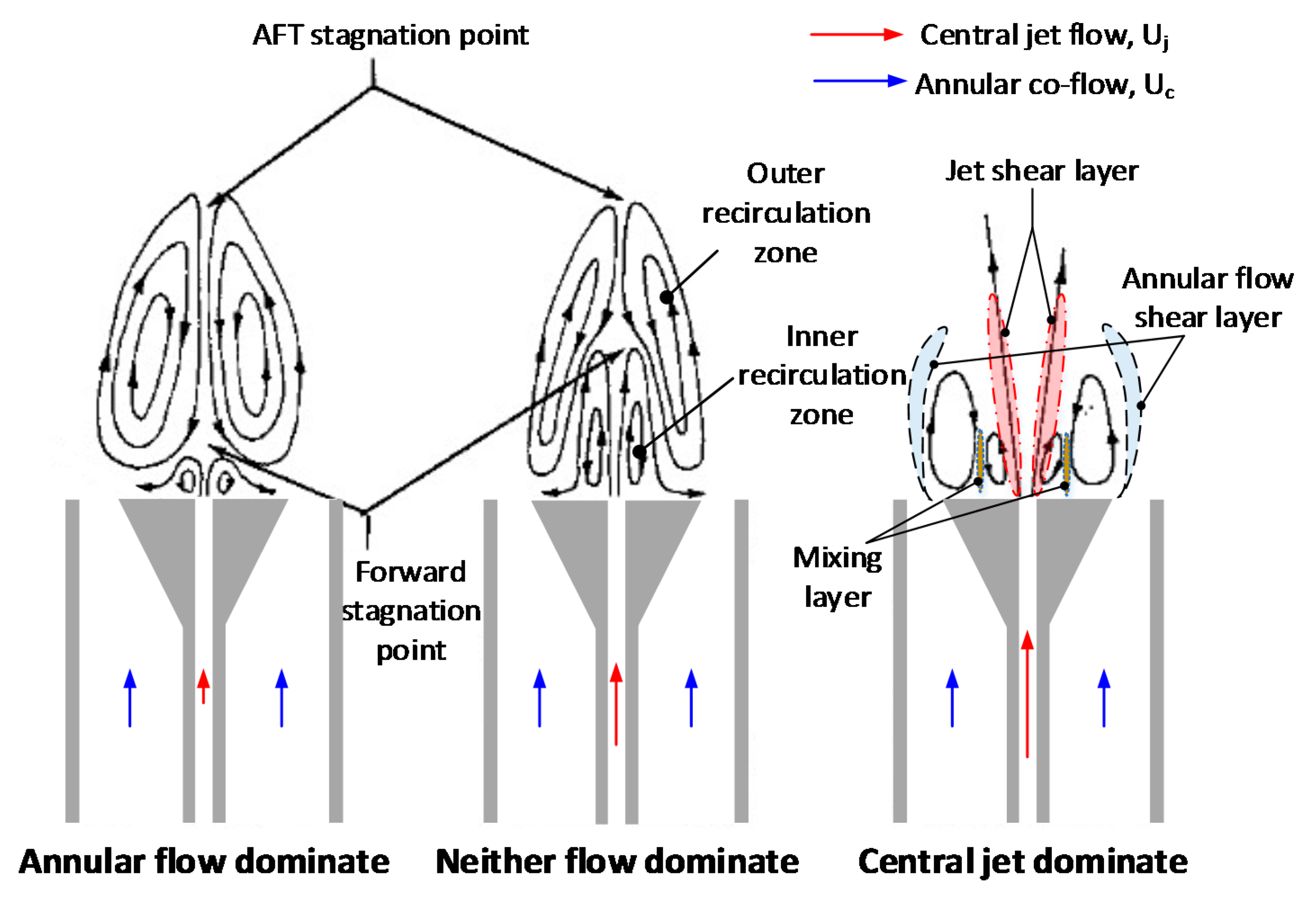
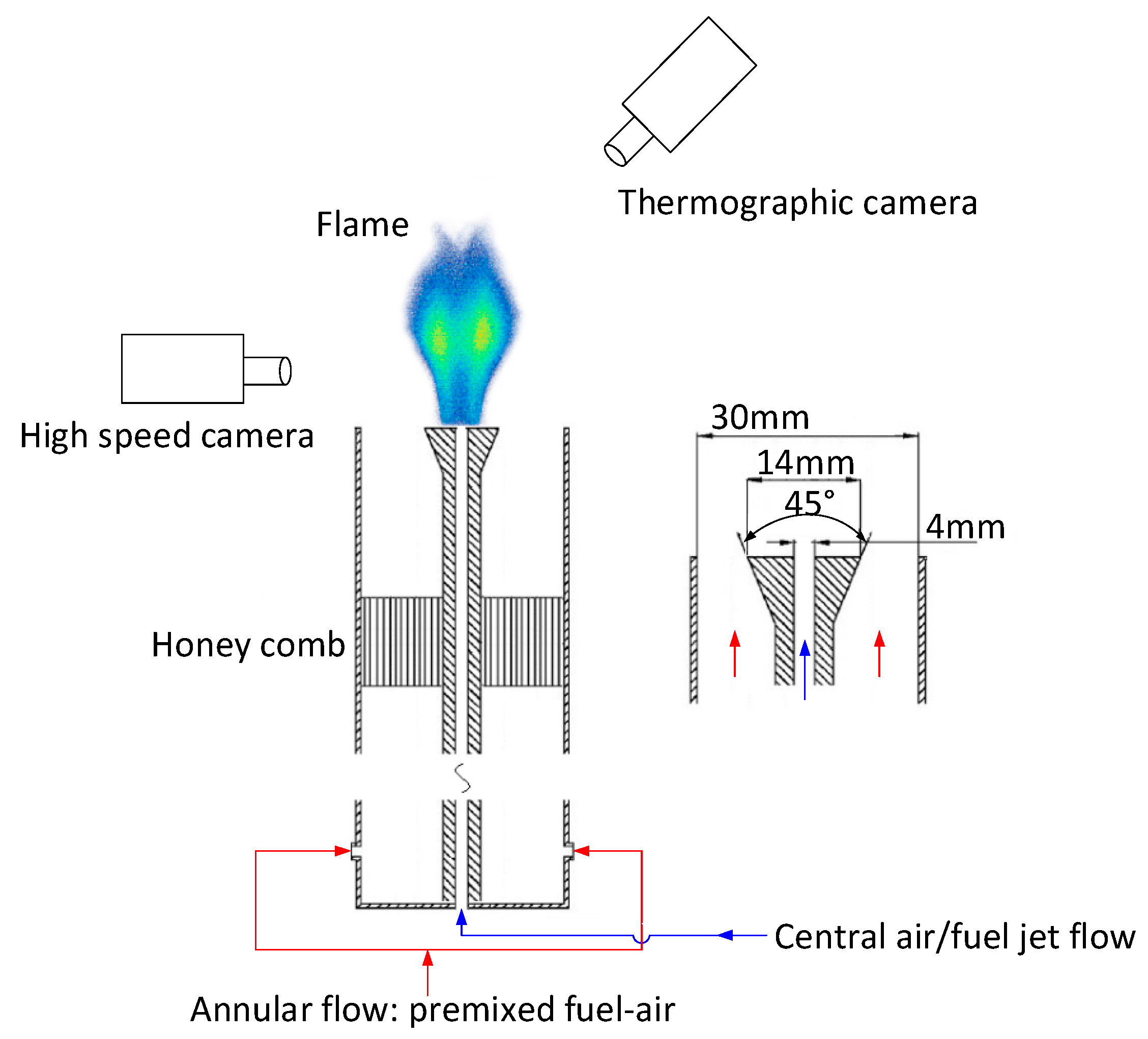

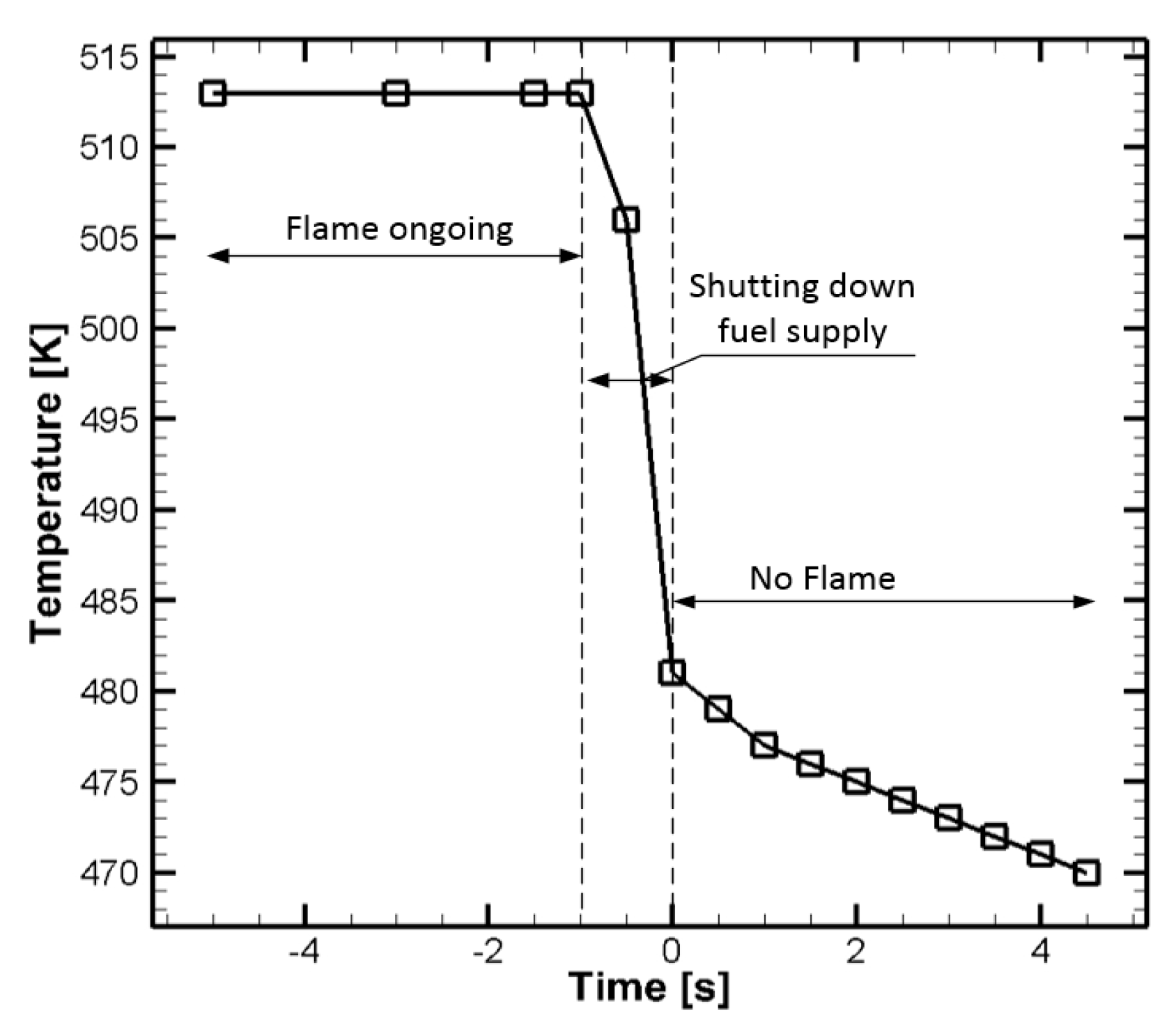
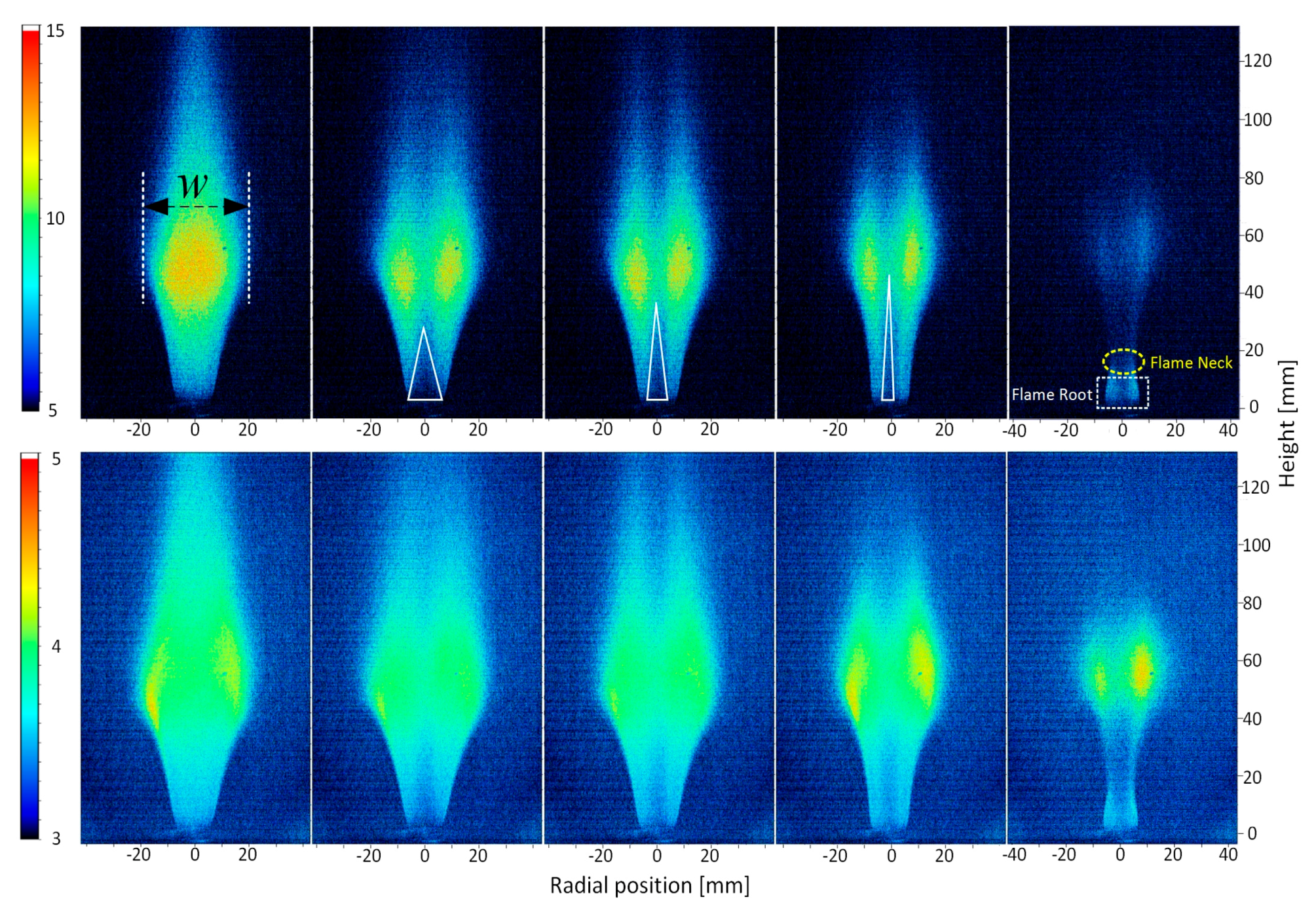

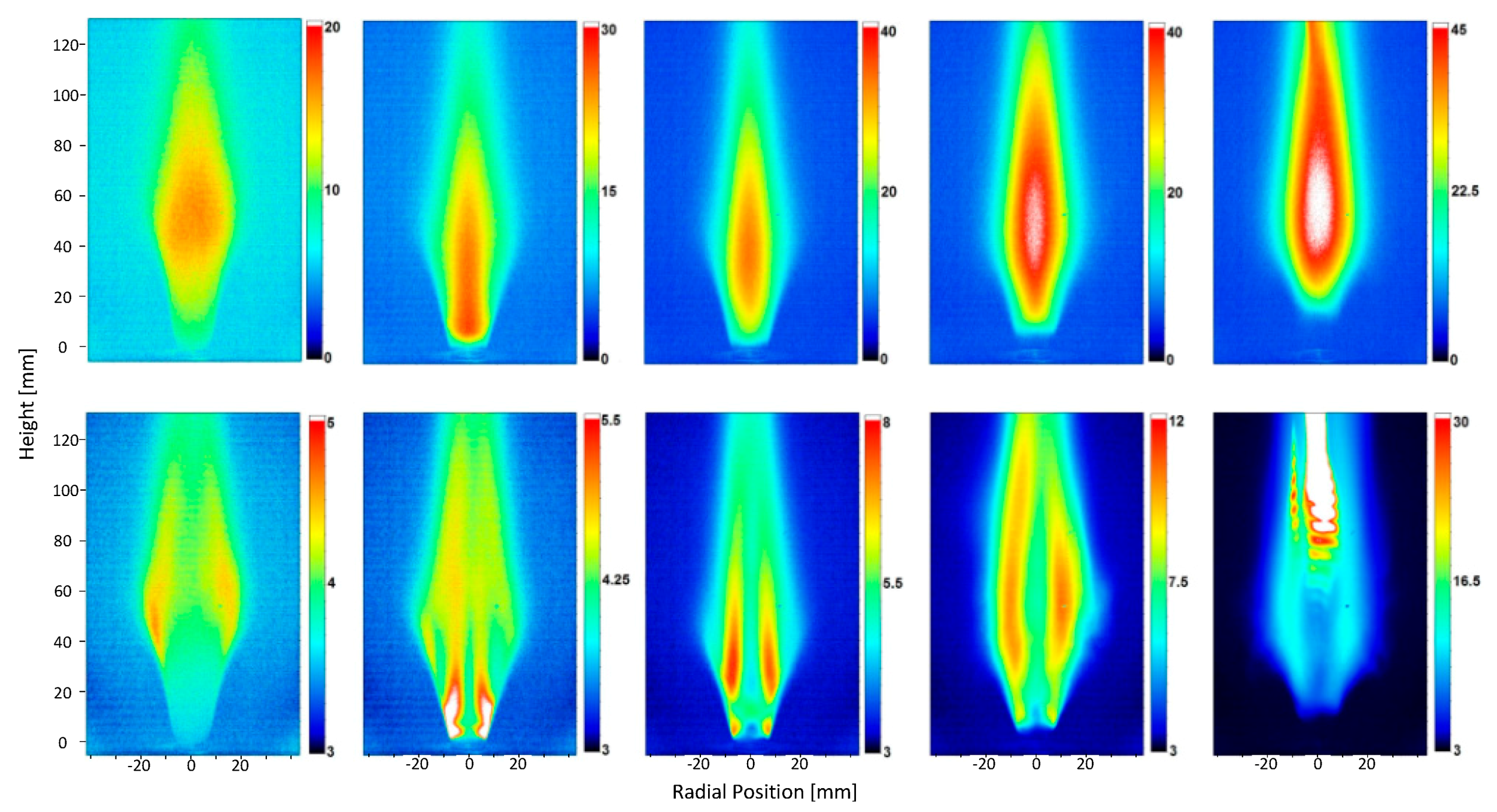



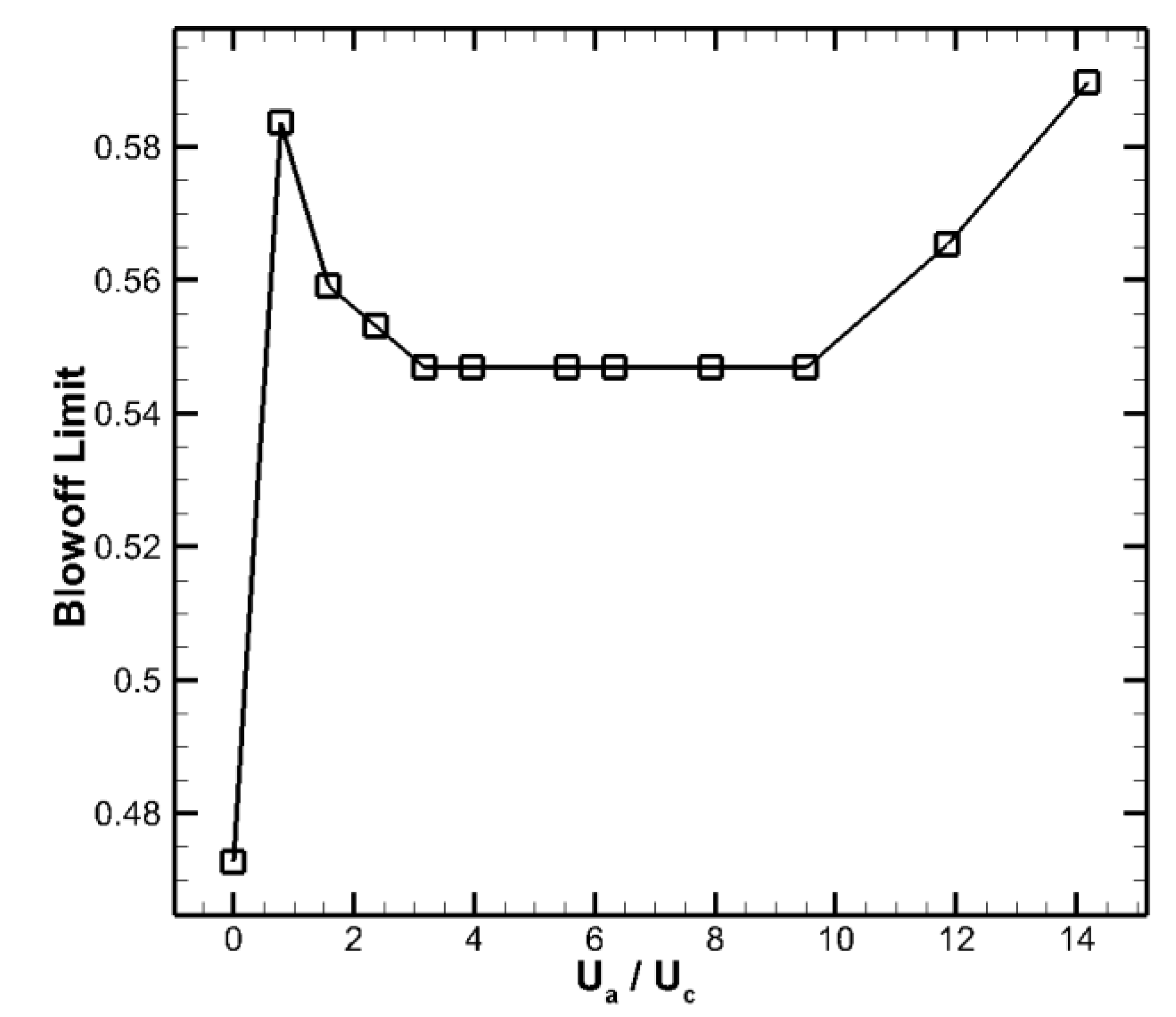
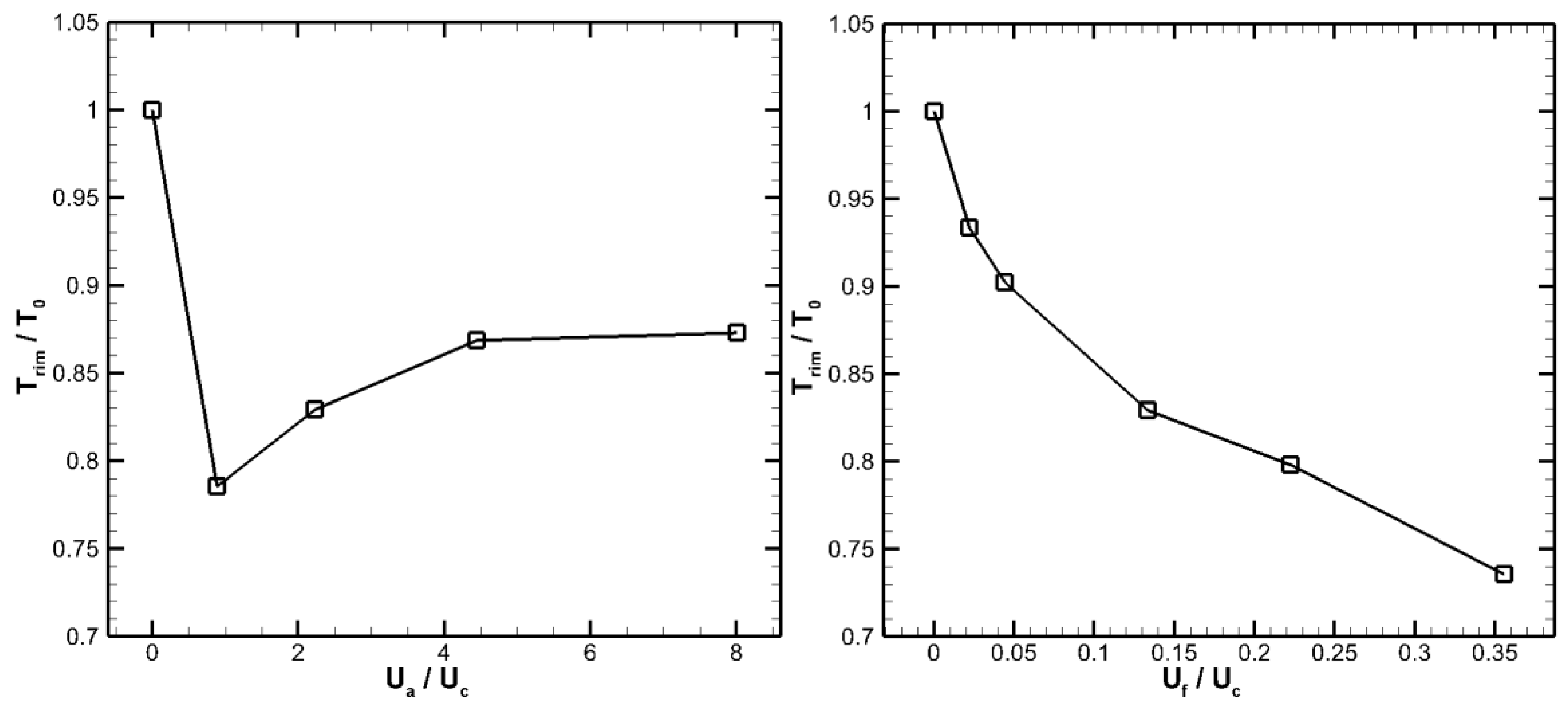
© 2017 by the authors. Licensee MDPI, Basel, Switzerland. This article is an open access article distributed under the terms and conditions of the Creative Commons Attribution (CC BY) license (http://creativecommons.org/licenses/by/4.0/).
Share and Cite
Tong, Y.; Chen, S.; Li, M.; Li, Z.; Klingmann, J. Experimental Study on Bluff-Body Stabilized Premixed Flame with a Central Air/Fuel Jet. Energies 2017, 10, 2011. https://doi.org/10.3390/en10122011
Tong Y, Chen S, Li M, Li Z, Klingmann J. Experimental Study on Bluff-Body Stabilized Premixed Flame with a Central Air/Fuel Jet. Energies. 2017; 10(12):2011. https://doi.org/10.3390/en10122011
Chicago/Turabian StyleTong, Yiheng, Shuang Chen, Mao Li, Zhongshan Li, and Jens Klingmann. 2017. "Experimental Study on Bluff-Body Stabilized Premixed Flame with a Central Air/Fuel Jet" Energies 10, no. 12: 2011. https://doi.org/10.3390/en10122011
APA StyleTong, Y., Chen, S., Li, M., Li, Z., & Klingmann, J. (2017). Experimental Study on Bluff-Body Stabilized Premixed Flame with a Central Air/Fuel Jet. Energies, 10(12), 2011. https://doi.org/10.3390/en10122011




